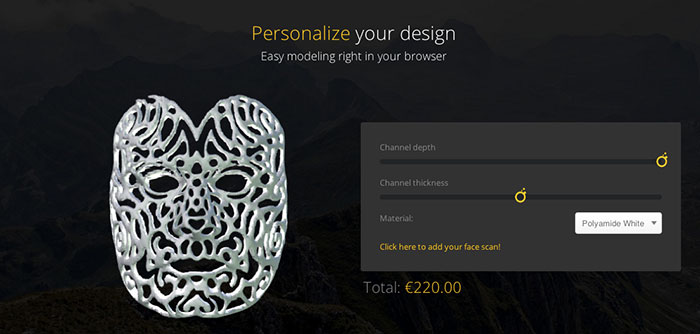One word that we are starting to hear more often and that we are likely to hear much more in the future is “parametric”, especially with respect to anything related to design software and the individualization capabilities of 3D printing technologies.
It is used to describe 3D modelling software that allows the 3D models to be easily modified in a more “harmonic” way by altering just a few values, instead of going into the model to hack away and disrupt it by tearing into lengths, sizes, positions, shapes and so forth.
It probably won’t surprise you to know that some 3D software and 3D printing design visionaries have been working on it for a while, most visibly for professional 3D CAD software, but others are now starting to put their solutions at the more general consumers’ fingertips. One of the first examples that I have been able to try is Uformit, a website that uses the advanced online interactive capabilities of WebGL (so no Safari for the full experience…) allowing designers and creators to share their designs for visitors to modify, personalize and purchase.
After launching at New York’s 3D Printshow last February, the team behind Uformit, which is directly linked with Norwegian software development studios Uformia, has kept a low profile and has been readying for the full public launch scheduled for today, April 10th. Ahead of that, though, they gave 3DPI the opportunity to go for a spin, I got the assignment, to see what they have to offer. I am impressed.
The technological innovation offered by Uformit is directly proportional to its accessibility; its potential is only limited by the number of modifiable designs present on the website, which currently stands at six, by three different artists and one by the Uformit’s internal design team. It’s early days.
When Hans Christian Gjøvik, Uformit’s co-founder and managing director, presented the new platform — or ‘software ecosystem’ — he used bold words, saying the project intends to leverage a revolutionary new 3D modelling software to make the idea of going from “one size fits all” to “one size fits one” a reality today. From the first rapid visit to Uformit, the project seems to stand up to the assertion.
Parametric modification of pendants and jewels is fun, especially with WebGL, and allows you to seamlessly move the 3D digital model around and view it as if it were already physical. The most interesting part is biometric modification, which Uformit properly describes as “the ultimate personalization”. Some of the designs – such as the Self Portrait Mask and the Self Portrait Pendant, include a Biometric Data option. Selecting it you will be asked to upload a biometric scan, in this particular case that of your own face which, thanks to Fuel 3D at last year’s 3D Printshow in London, I already have and had always known it was going to come in handy someday.
The team will then proceed to process and review the data to input it into the parametric system. Once your personal data is loaded you will be able to make jewels and objects fit exactly and only for your. They can then be shared on social networks or 3D printed (laser sintered) in polyamide or in metal and shipped directly out to you, something that is amazing in and of itself and yet we are already used to.
[nggallery id=165]Although it is one of the first expressions of parametric 3D modelling available to the public, Uformit’s ecosystem potential probably goes well beyond jewellery and designs. Medical, dental, clothing and general apparel applications are likely to follow suit. And, as Hans Christian Gjøvik said when introducing it, it is likely to “herald a new era in design and technology.”




